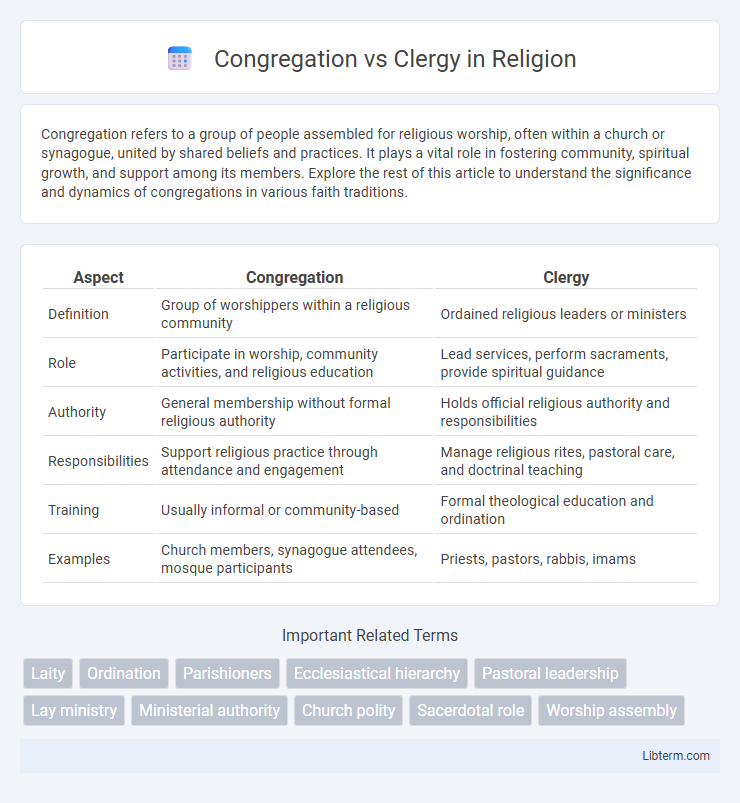Congregation refers to a group of people assembled for religious worship, often within a church or synagogue, united by shared beliefs and practices. It plays a vital role in fostering community, spiritual growth, and support among its members. Explore the rest of this article to understand the significance and dynamics of congregations in various faith traditions.
Table of Comparison
| Aspect | Congregation | Clergy |
|---|---|---|
| Definition | Group of worshippers within a religious community | Ordained religious leaders or ministers |
| Role | Participate in worship, community activities, and religious education | Lead services, perform sacraments, provide spiritual guidance |
| Authority | General membership without formal religious authority | Holds official religious authority and responsibilities |
| Responsibilities | Support religious practice through attendance and engagement | Manage religious rites, pastoral care, and doctrinal teaching |
| Training | Usually informal or community-based | Formal theological education and ordination |
| Examples | Church members, synagogue attendees, mosque participants | Priests, pastors, rabbis, imams |
Understanding Congregation and Clergy: Key Differences
The congregation refers to the body of worshippers or members within a religious community who participate in services and activities, while the clergy comprises ordained leaders responsible for spiritual guidance, rituals, and church administration. Clergy often hold titles such as priests, pastors, or ministers and undergo formal theological training and ordination, distinguishing them from the lay members of the congregation. Understanding these key differences highlights the distinct roles and responsibilities that shape religious practice and community dynamics.
Historical Origins of Congregation and Clergy Roles
The historical origins of congregations trace back to early Christian communities that gathered for worship, fellowship, and mutual support, establishing a foundational model for communal religious practice. Clergy roles emerged as distinct, ordained leaders responsible for spiritual guidance, sacramental duties, and maintaining doctrinal integrity, evolving from informal local leaders to organized ecclesiastical hierarchies. This differentiation between congregation and clergy solidified during the early centuries of Christianity, shaping the structural and functional dynamics of religious institutions.
Biblical Foundations for Congregation and Clergy
The Biblical foundation for congregation emphasizes the assembly of believers as the body of Christ, highlighted in passages such as 1 Corinthians 12:27, where each member plays a vital role in spiritual growth and unity. Clergy are established through scriptural mandates found in Titus 1:5 and 1 Timothy 3:1-7, outlining specific qualifications and responsibilities for elders or overseers to shepherd the flock. This dual structure ensures that congregations are empowered by the ministry of clergy who provide spiritual guidance, teaching, and pastoral care according to biblical principles.
Core Responsibilities of the Clergy
The core responsibilities of the clergy include leading religious services, providing spiritual guidance, and administering sacraments to the congregation. Clergy members also engage in pastoral care, counseling individuals and families through life challenges and spiritual growth. Their role extends to community leadership, coordinating religious education, and fostering the moral and ethical development of their congregants.
Essential Functions of the Congregation
The essential functions of the congregation include worship, fellowship, discipleship, mission, and service, serving as the spiritual foundation and communal body of the church. Congregations support clergy by providing a context for ministry, facilitating the practical outworking of faith through communal participation and stewardship. While clergy lead spiritual guidance and sacramental duties, the congregation actively sustains church life through engagement, decision-making, and the nurturing of members' spiritual growth.
The Relationship Between Clergy and Congregation
The relationship between clergy and congregation is foundational to the spiritual and social life of religious communities, fostering mutual support and guidance. Clergy provide religious leadership, pastoral care, and interpretation of sacred texts, while the congregation offers participation, feedback, and trust, creating a dynamic interaction essential for communal faith practices. Effective communication and shared values strengthen this bond, enhancing both individual spiritual growth and collective worship experiences.
Leadership Structures in Various Faith Traditions
Leadership structures in various faith traditions differ significantly between congregation and clergy roles, with congregations often serving as the community base and clergy providing spiritual guidance and doctrinal leadership. In Protestant denominations, congregational governance empowers members with decision-making authority, while clergy act as facilitators and teachers. Conversely, Catholic and Orthodox traditions centralize authority within the clergy hierarchy, including bishops and priests, who lead congregations with defined doctrinal and liturgical responsibilities.
Evolving Roles: Modern Changes in Congregation and Clergy
Congregations have increasingly embraced more participatory roles, shifting from passive attendance to active involvement in services and community decision-making. Clergy roles have evolved to emphasize pastoral care, counseling, and social justice advocacy alongside traditional ritual leadership. This transformation reflects broader societal trends towards inclusivity and collaborative leadership within religious communities.
Challenges Faced by Congregations and Clergy Today
Congregations face challenges such as declining attendance, generational shifts in belief systems, and balancing tradition with modern societal values. Clergy struggle with burnout, maintaining relevance in digital spaces, and navigating complex social issues that impact their pastoral roles. Both groups encounter difficulties in fostering community engagement amid increasing secularization and diverse cultural dynamics.
Building Unity Between Congregation and Clergy
Building unity between congregation and clergy hinges on fostering open communication and mutual respect, encouraging active participation from both groups in worship and decision-making processes. Collaborative initiatives such as community service projects and shared educational programs create a sense of common purpose and strengthen relational bonds. Emphasizing transparency and empathy within church leadership cultivates trust and reinforces the spiritual connection essential for a unified religious community.
Congregation Infographic

 libterm.com
libterm.com